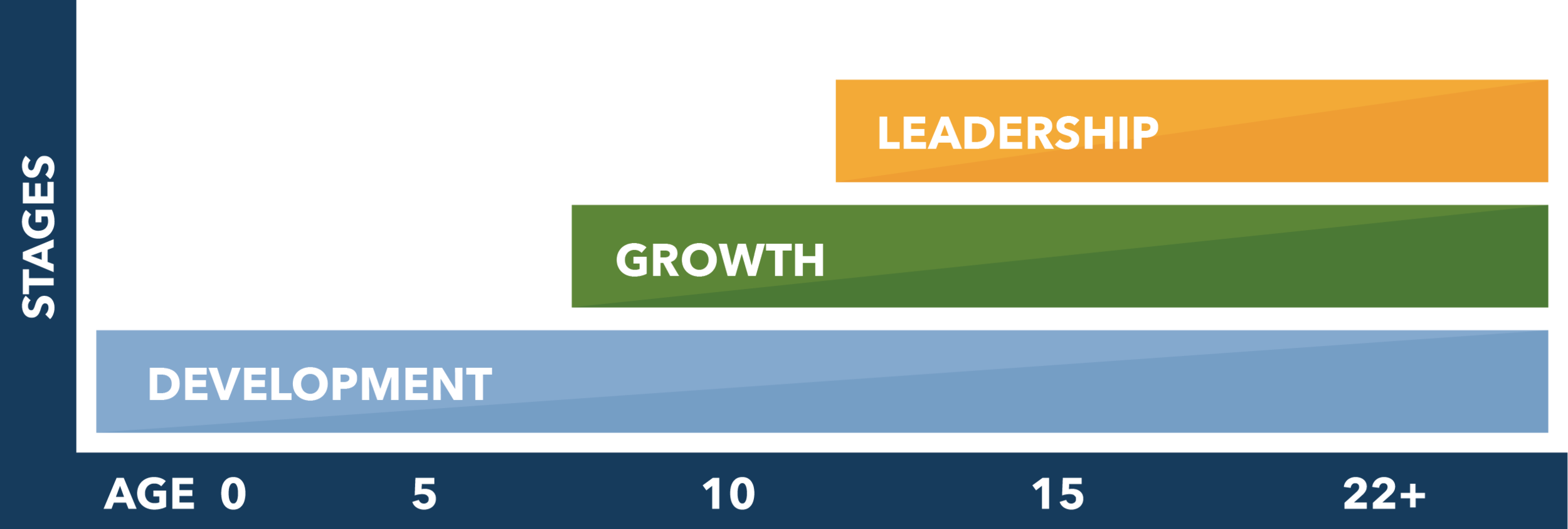
DEVELOPMENT
The junior golfer takes center stage as we work to surround them with an experienced team to assist in their long-term growth and development. With our holistic training model, we equip each player with the necessary tools and training to be successful on and off the golf course.
Player Assessment – Identifying areas of strength & improvement and understanding a player’s competitive skillset, monitoring progress through statistical analysis, measured practice, and tournament competition.
Goal Setting – Establishing long-term goals, short-term action plans, and weekly practice plans.
Growth Mindset – Implementing a long-term development timeline and a clear and simple understanding of how to improve over time.
Accountability – Executing a structured plan on a consistent basis with your development team.
Team Players – Recommending qualified experts for swing instruction, fitness, psychology, etc. as needed and working with each to solidify a plan for development.
Active Start - (0-6 years old) start playing the game of golf and learn the fundamentals, emphasis on fun
Learn to play - (7-12) start to play 9 to 18 holes on the course and keep score
Train to play - (10-12) start training skills using games, learn to cope with the physical and mental challenges of golf,
Learn to compete - (12-14) - learn how to play tournament golf, assemble necessary coaches, begin to build on tournament experiences
Train to compete - (14-18) - refine goals & training, optimization of golf-specific skill set, high-level tournament experiences
Train to excel - (18-22) achieve a high degree of excellence at the amateur or collegiate level
Elite Excel - (22+) become an elite player at the amateur or professional level
GROWTH
We walk alongside each junior to properly identify their dream, target, and safety schools. We use our proprietary learning platform, player assessment model, school-specific research, data analytics, and our industry connections to assist each family throughout the recruiting process.
College Preferences Assessment – Providing a “best-fit” college analysis using the Academic, Athletic, and Social “pillars”.
Marketing Plan – Developing a portfolio of assets: website, swing video, resume, personal interview, and intro letters.
NCAA Education – Understanding the complexities of the college golf guidelines and timelines.
School Database – Designing a personalized database geared toward the academic, athletic, and social needs/preferences of each individual player.
School Research – Acquiring a genuine understanding of each school, coach, and golf program through advanced research and classifying each as a potential dream, target, or safety school.
Targeted Coach Outreach – Managing a communication plan with College Coaches and coordinating outreach and follow-up. Communication practice and preparation for interactions with Coaches.
Passive Start - (12-13) middle school, passively thinking, learning, and researching about life in college
Assessment - (13-14) end of 7th grade
Research & Education - (14-15) PSA at the beginning of 9th-grade year
Active Start - (15-16) June 15th after Sophomore year
Management - (15-17) communication with Coaches
Selection - (16-18) taking visits, scholarship agreement, sign NLI
Transition - (18+) making the leap to college golf
LEADERSHIP
Our coaching framework is focused on helping students become effective leaders. Our goal is to provide a learning environment to support personal growth and present our players with real-life situations where they’ll have the opportunity to learn leadership skills they can employ the rest of their life.
Personal Responsibility – Learning to act professionally, come prepared for meetings, follow thru with commitments, make personal decisions, and show good judgment.
Leadership Development – Transitioning up the “leadership ladder” from an emerging leader to an intentional leader, to a mentoring leader.
Time Management – Planning and organizing a schedule and learning how to divide time between specific activities. Learning to work smarter, not harder to minimize stress.
Growing a Network – Expanding your social circle, volunteer work, community work, using resources as necessary in everyday life.
Preparing for College – Brushing up on socialization skills, find available resources, understand basic finances, open up to new experiences, and understand their hierarchy of priorities.
Training to be ready for competitive college golf – Emphasising the complexities of college golf, and a special focus on health, wellness, and conditioning for college athletes.
Passive Start - (0-8) passively watching, learning, and observing leaders as they lead others
Learn to Lead - (8-10) - understanding the basic traits, tactics, and skills of leadership and what it takes to lead
Active Start - (10-12) - implementing the fundamental skills of leadership in sport and life
Personal Responsibility - (12-14) - showing responsibility for commitments and decisions
Emerging Leader - (14-15) - taking on additional levels of responsibility
Intentional Leader - (15-16)- influencing a group of people or having the ability to influence their decisions
Mentoring Leader - maybe (16+) - mentoring other leaders by investing in their development and creating additional opportunities












